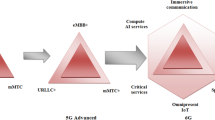Abstract
Nowadays, smart mobile devices drive the mobile traffic growth rapidly. Most smart mobile devices are equipped with multiple radio network interfaces, such as High Speed Packet Access (HSPA), Long Term Evolution (LTE), and Wi-Fi. Therefore, integration of multiple networks is a viable solution to fulfill traffic offloading and the Quality-of-Service (QoS) requirement of data usage for mobile users. In this paper, we propose a multi-link mechanism to handle the radio network selection and switching between LTE and Wi-Fi networks. A Multi-Link Adaptor (MLA) and a Multi-Connection Manager (MCM) are proposed for the User Equipment (UE) and the core network, respectively, to handle the multi-link mechanism. The applications executed in the UEs do not need to be modified under the proposed approach. The MLA maintains a QoS class table and a routing table for the network selection procedure and uses the GPRS Tunneling Protocol-Control plane (GTP-C) control messages to execute network switching. In the future, we will measure the throughput of the multi-link network and the switch delay between the heterogeneous radio networks.





Similar content being viewed by others
References
Cisco Corporation. (2012). Cisco visual networking index: Global mobile data traffic forecast update 2011–2016. Cisco white paper.
Yu, C., Hwang, A. (2013). Taiwan market: Chunghwa telecom begins EAP-SIM off-loading of 3G traffic onto Wi-Fi. News. DIGITIMES. http://www.digitimes.com/pda/a20130115PD201.html. Accessed April 25, 2013
3GPP. (2013). Evolved general packet radio service (GPRS) tunnelling protocol for control plane (GTPv2-C), Stage 3. 3GPP TS 29.274 (Version 12.0.0).
3GPP. (2013). General packet radio system (GPRS) tunnelling protocol user plane (GTPv1-U). 3GPP TS 29.281 (Version 11.6.0).
Gundavelli, S., Leung, K., Devarapalli, V., Chowdhury, K., Patil, B. (2008). Proxy mobile IPv6. IETF RFC 5213.
Trung, T. M., Han, Y.-H., Choi, H.-Y., Geun, H. Y. (2011). A design of network-based flow mobility based on proxy mobile IPv6. In IEEE conference on, computer communications workshops (INFOCOM WKSHPS).
Ramaboli, A. L., Falowo, O. E., & Chan, A. H. (2012). Bandwidth aggregation in heterogeneous wireless networks: A survey of current approaches and issues. Journal of Network and Computer Applications, 35(6), 1674–1690.
3GPP. (2013). Evolved universal terrestrial radio access (E-UTRA) and evolved universal terrestrial radio access network (E-UTRAN), Overall description, Stage 2. 3GPP TS 36.300 (Version 11.5.0).
Firmin, F. (2012). The evolved packet core. 3GPP MCC. http://www.3g.pp.org/The-Evolved-Packet-Core. Accessed April 30, 2013
3GPP. (2013). Architecture enhancements for non-3GPP accesses. 3GPP TS 23.402 (Version 12.0.0).
3GPP. (2012). 3GPP system to wireless local area network (WLAN) interworking, WLAN user equipment (WLAN UE) to network protocols, Stage 3. 3GPP TS 24.234 (Version 11.3.0).
Lin, Y.-B., & Pang, A.-C. (2005). Wireless and mobile All-IP networks. Hoboken, NJ: Wiley.
3GPP. (2012). Quality of service (QoS) concept and architecture. 3GPP TS 23.107 (Version 11.0.0).
3GPP. (2013). Non-access-stratum (NAS) protocol for evolved packet system (EPS), Stage 3. 3GPP TS 24.301 (Version 12.0.0).
3GPP. (2012). Telecommunication management, performance management (PM), performance measurements evolved universal terrestrial radio access network (E-UTRAN). 3GPP TS 32.425 (Version 11.4.0).
3GPP. (2012). Telecommunication management, self-organizing networks (SON), concepts and requirements. 3GPP TS 32.500 (Version 11.1.0).
Postel, J. (1981). Internet control message protocol. IETF RFC 792.
Acknowledgments
This paper was supported in part by NSC 101-2221-E-009-032, Academia Sinica AS-102-TP-A06, Chunghwa Telecom, Nokia Siemens Networks, ITRI/NCTU JRC Research Project, the ICL/ITRI Project, Department of Industrial Technology (DoIT) Academic Technology Development Program 101-EC-17-A-03-S1-193, the MoE ATU plan, and the Technology Development Program of the Ministry of Economic Affairs (MoEA TDP), Taiwan.
Author information
Authors and Affiliations
Corresponding author
Rights and permissions
About this article
Cite this article
Yang, SN., Lin, YC., Gan, CH. et al. A Multi-link Mechanism for Heterogeneous Radio Networks. Wireless Pers Commun 76, 661–674 (2014). https://doi.org/10.1007/s11277-013-1357-8
Published:
Issue Date:
DOI: https://doi.org/10.1007/s11277-013-1357-8




